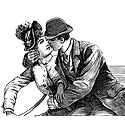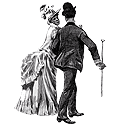
The Collect Pond
In the early days of New Amsterdam, Manhattan’s safest source of fresh water was the Collect Pond, located a half-mile northeast of Wall Street’s city wall. “The Collect was out in the ‘wilderness’ of Manhattan,” says Beverly Swerling, author of the New York historical novel City of Dreams. “That made it quite secluded, a little dangerous, and very, very romantic.”
Today: The Collect Pond has become Collect Pond Park, a threadbare greenspace in the midst of the city’s government offices, and a parking lot. It’s a good place for a date if you’re waiting for test results from the city health clinic across the street.

The Locust Trees
By the 1640s, the children of the first Dutch settlers were approaching adulthood. On romantic spring evenings,historian Charles Opdyke writes, lovers “would resort to the ‘Locust trees’ on a bluff of the [Hudson River], a little south of the present Trinity Church, which was then the West India Company’s garden.” It was such a popular make-out spot that unmarried people were banned from congregating there.
Today: If attempting a romantic sidewalk interlude at the intersection of Broadway and Rector, try not to get run over by the many road-repair crews and tourists.
The Kissing Bridges
There was one spanning the Mill Stream, at about 52nd Street and Second Avenue, and another at what is now 77th Street and Third Avenue. The British Reverend Andrew Burnaby, who visited New York in the late 1750s, noted, “Just before you enter the town there is a little bridge, commonly called the Kissing Bridge, where it is customary, before passing beyond, to ‘salute’ the lady who is your companion, a custom which is curious, yet not displeasing.”
Today: Taking a date to Mimi’s, a boisterous piano bar on the corner of 52nd and Second Avenue, or Lenox Hill Hospital, at 77th and Third, is unlikely to put anyone in the mood.

The Shelters in Central Park
Central Park’s secluded trails of the Ramble and dark, romantic places under some of the 36 bridges seem to have been specifically built for young lovers. But by far the most popular spots have been the boat landings and other shelters situated around the park. These small wooden buildings, usually overlooking serene, picturesque sights, have provided lovers with a bit of seclusion ever since the park was opened. Easily the most romantic: the shelter on Dene Rock, near East 68th Street.
Today: World-renowned for alfresco gay sex in the seventies, the shelters in Central Park were ceded in the eighties to the homeless, who have been there ever since.
Coney Island and the Boardwalk
Amusement parks were one of the few places where Gilded Age men and women could share their leisure activities. Coney Island has boasted more than a half-dozen enclosed water rides ideal for private canoodling—most famously the Canals of Venice, the Old Mill, and the Tunnel of Love. But when the Riegelmann Boardwalk was built in 1923, lovers found a new place to be alone. According to NYU assistant professor Joyce Gold, so much fooling around went on beneath the boardwalk that it became known as “the Hotel Underwood.”
Today: The continued presence of “Coney Island Whitefish” prove that even today, lovers find the boardwalk alluring.

Fort Tryon Park, the Cloisters
When it opened to the public in 1935, Fort Tryon Park instantly became one of the greatest lovers’ lanes in the city’s history. Jeff Kisseloff, in his oral history You Must Remember This, quotes several area residents on the romantic uses of the park. The verdict, coyly given by a longtime Washington Heights resident: “It was pretty wild.”
Today: The Cloisters, the trees, the rolling hills, and the view of the Palisades still make this one of the best make-out spots.